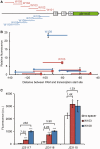Programmable repression and activation of bacterial gene expression using an engineered CRISPR-Cas system
- PMID: 23761437
- PMCID: PMC3753641
- DOI: 10.1093/nar/gkt520
Programmable repression and activation of bacterial gene expression using an engineered CRISPR-Cas system
Abstract
The ability to artificially control transcription is essential both to the study of gene function and to the construction of synthetic gene networks with desired properties. Cas9 is an RNA-guided double-stranded DNA nuclease that participates in the CRISPR-Cas immune defense against prokaryotic viruses. We describe the use of a Cas9 nuclease mutant that retains DNA-binding activity and can be engineered as a programmable transcription repressor by preventing the binding of the RNA polymerase (RNAP) to promoter sequences or as a transcription terminator by blocking the running RNAP. In addition, a fusion between the omega subunit of the RNAP and a Cas9 nuclease mutant directed to bind upstream promoter regions can achieve programmable transcription activation. The simple and efficient modulation of gene expression achieved by this technology is a useful asset for the study of gene networks and for the development of synthetic biology and biotechnological applications.
Figures




Similar articles
-
Molecular and structural characterization of the PezAT chromosomal toxin-antitoxin system of the human pathogen Streptococcus pneumoniae.J Biol Chem. 2007 Jul 6;282(27):19606-18. doi: 10.1074/jbc.M701703200. Epub 2007 May 8. J Biol Chem. 2007. PMID: 17488720
-
Use of a Phosphorylation Site Mutant To Identify Distinct Modes of Gene Repression by the Control of Virulence Regulator (CovR) in Streptococcus pyogenes.J Bacteriol. 2017 Aug 22;199(18):e00835-16. doi: 10.1128/JB.00835-16. Print 2017 Sep 15. J Bacteriol. 2017. PMID: 28289082 Free PMC article.
-
crRNA and tracrRNA guide Cas9-mediated DNA interference in Streptococcus thermophilus.RNA Biol. 2013 May;10(5):841-51. doi: 10.4161/rna.24203. Epub 2013 Mar 27. RNA Biol. 2013. PMID: 23535272 Free PMC article.
-
Transcription activation by catabolite activator protein (CAP).J Mol Biol. 1999 Oct 22;293(2):199-213. doi: 10.1006/jmbi.1999.3161. J Mol Biol. 1999. PMID: 10550204 Review.
-
Applications of Cas9 as an RNA-programmed RNA-binding protein.Bioessays. 2015 Jul;37(7):732-9. doi: 10.1002/bies.201500001. Epub 2015 Apr 16. Bioessays. 2015. PMID: 25880497 Free PMC article. Review.
Cited by
-
Proliferation Analyses of Conditional Knockdown Strains Using CRISPR Interference in Fission Yeast.Methods Mol Biol. 2025;2862:171-186. doi: 10.1007/978-1-0716-4168-2_12. Methods Mol Biol. 2025. PMID: 39527200
-
Identification and genetic dissection of convergent persister cell states.Nature. 2024 Nov 6. doi: 10.1038/s41586-024-08124-2. Online ahead of print. Nature. 2024. PMID: 39506104
-
Construction of multilayered gene circuits using de-novo-designed synthetic transcriptional regulators in cell-free systems.J Biol Eng. 2024 Nov 5;18(1):64. doi: 10.1186/s13036-024-00459-8. J Biol Eng. 2024. PMID: 39501344 Free PMC article.
-
Fine-tuning of a CRISPRi screen in the seventh pandemic Vibrio cholerae.BMC Genomics. 2024 Oct 21;25(1):985. doi: 10.1186/s12864-024-10891-1. BMC Genomics. 2024. PMID: 39433986 Free PMC article.
-
Arrayed CRISPRi library to suppress genes required for Schizosaccharomyces pombe viability.J Cell Biol. 2025 Jan 6;224(1):e202404085. doi: 10.1083/jcb.202404085. Epub 2024 Oct 8. J Cell Biol. 2025. PMID: 39378339
References
-
- Auslander S, Fussenegger M. From gene switches to mammalian designer cells: present and future prospects. Trends Biotechnol. 2012;31:155–168. - PubMed
-
- Miller JC, Tan S, Qiao G, Barlow KA, Wang J, Xia DF, Meng X, Paschon DE, Leung E, Hinkley SJ, et al. A TALE nuclease architecture for efficient genome editing. Nat. Biotechnol. 2011;29:143–148. - PubMed
Publication types
MeSH terms
Substances
Grants and funding
LinkOut - more resources
Full Text Sources
Other Literature Sources
Research Materials


